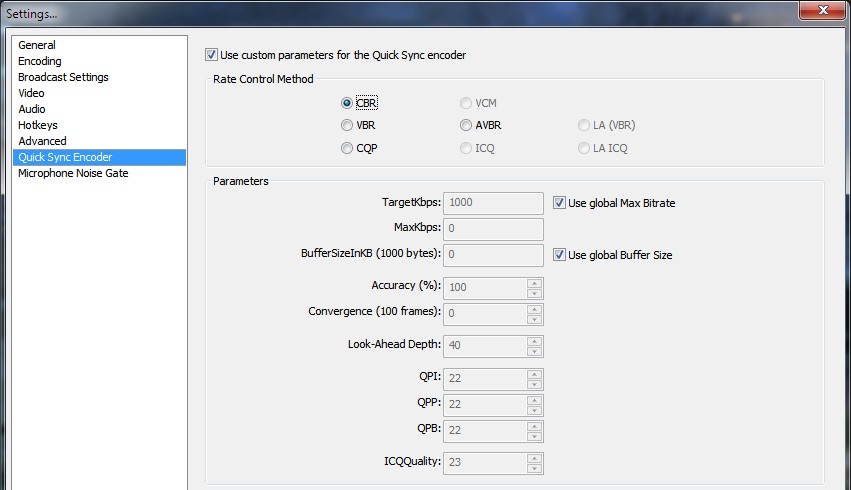

Quality is determined by the ICQQuality parameter (1.51), where 1 corresponds to the best quality. Recording with a constant quality, similar to the CRF mode of x.264, that makes better usage of the bandwith than CQP mode. ICQ: intelligent constant quality algorithmĭescription: A better version of the CQP mode. The larger the Look-Ahead, the better the quality. The higher the bitrate, the better the quality. Quality is determined by the bitrate and the Look-Ahead depth (1.100). Huge latency and increased memory consumption due to extensive analysis of several dozen frames before the actual encoding. This is not constant enough for streaming like the VBR algorithm (not HRD compliant).ĭescription: A better version of the VBR algorithm. Quality of high complex scenes is determined by the Accuracy and Convergence parameters.


Allows spikes in bitrate consumption for short high complex scenes to maintain quality. Use case: recording with a variable bit rate.ĭescription: The algorithm focuses on overall encoding quality while meeting the specified bitrate, TargetKbps, within the accuracy range Accuracy, after a Convergence period. Lower values than 22 greatly increases the bitrate requirement.ĪVBR: average variable bit rate control algorithm My choice is 22 with a maximum bit rate of 50000, which results in an average bit rate of about 29000 while keeping high complex scenes at maximum quality. The lower the values, the better the quality. Quality is determined by the 3 QP parameters (1.51). Remark: Very good for local recording for raw footage, since quality is not restricted to bitrate if you set the bitrate high enough, while not wasting disk space on low complex scenes. You want to use the same value for all 3 parameters. QPI determines intra frame quality (known as key frames), QPP determines predicted (P-) frames quality, and QPB determines h.264 B-frames (a weaker version of P-frames). Quality is determined by QPI, QPP and QPB parameters. Bitrate is determined by the complexity of the video material. Use case: recording with a variable bit rateĭescription: Video is encoded with a constant quality, regardless of motion. The higher the bitrate, the better the quality.ĬQP: constant quantization parameter algorithm Quality is determined by the 2 bitrate parameters. Remark: According to the SDK description, this algorithm is HRD compliant and can probably be used fine with streaming, although it is not a strict constant bit rate algorithm. Use case: realtime, recording and streaming with a variable bitrateĭescription: Video is encoded with target bitrate TargetKbps, while allowing MaxKbps spikes that smooth out using a buffer, whose size is determined by the global buffer size or BufferSizeInKB. Use case: streaming or recording with a constant bit rate.ĭescription: Bitrate is determined by the "Max Bitrate" setting in Encoding->Video Encoding or TargetKbps if "use global Max Bitrate" in Quick Sync Encoder Settings is unchecked. It depends on your hardware which algorithms are available. VBR may be suited, but all other algorithms are definitely not suited for streaming.įor local recording, use LA ICQ -> ICQ -> CQP -> LA (VBR) -> AVBR -> VBR -> CBR Otherwise use CBR, in which case you don't need any custom parameter at all. You can try VBR, and if the streaming service doesn't complain, keep it. If available, Quick Sync is activated in Settings -> Encoding: You can get very high quality footage with almost zero CPU usage by using Quick Sync. As long as streaming providers require constant bitrates, it makes no sense to dig into the custom settings.īut if you don't want to stream but record locally with high quality, it may be worth to look into the custom parameters. This seems especially true if you want to stream your video, because the custom settings only provide additional algorithms suitable for local recording with variable bitrates that are not very suitable for streaming. In general, you are fine if you just choose from the presets in Settings->Advanced and don't activate any of the custom settings. It may help you to determine which algorithm is best suited for your use case. I looked a bit into the Quicksync API documentation, and this is what I have found out about the custom parameters of the Quick Sync encoder.
#Cqp recording quicksync obs how to
If you just want to know how to activate Quicksync, look here.


 0 kommentar(er)
0 kommentar(er)
